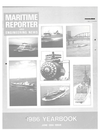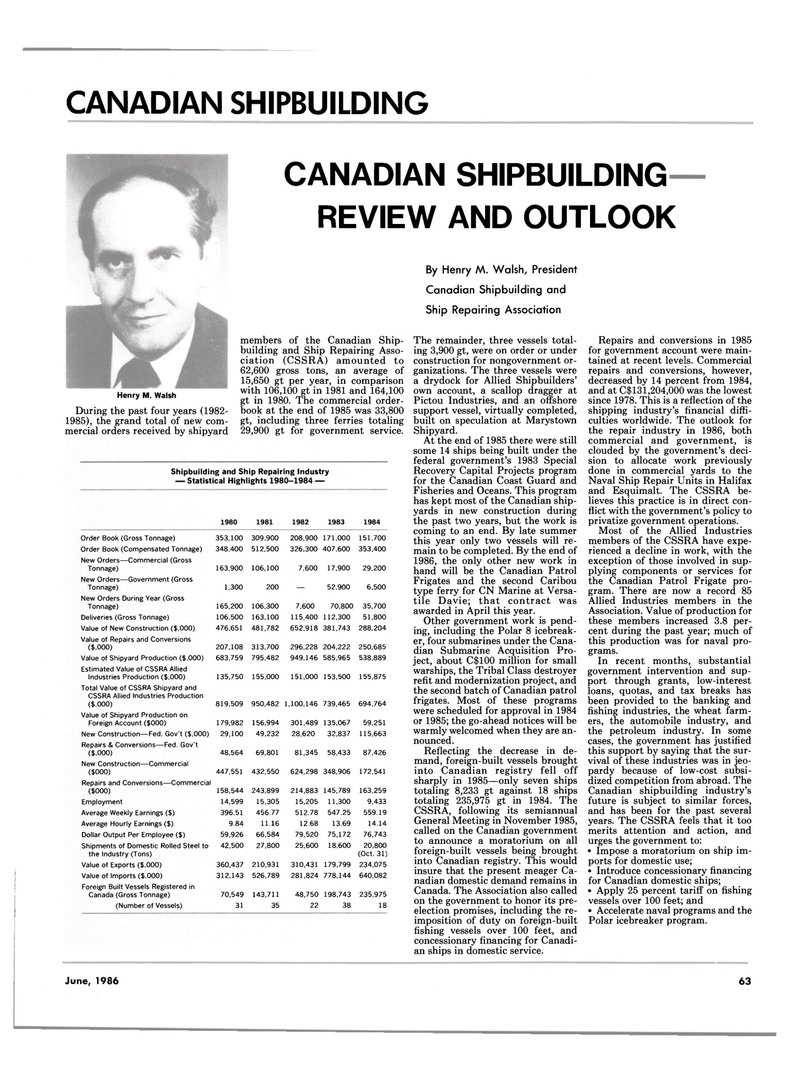
Page 63: of Maritime Reporter Magazine (June 1986)
Read this page in Pdf, Flash or Html5 edition of June 1986 Maritime Reporter Magazine
CANADIAN SHIPBUILDING
CANADIAN SHIPBUILDING
REVIEW AND OUTLOOK
Henry M. Walsh
During the past four years (1982- 1985), the grand total of new com- mercial orders received by shipyard members of the Canadian Ship- building and Ship Repairing Asso- ciation (CSSRA) amounted to 62,600 gross tons, an average of 15,650 gt per year, in comparison with 106,100 gt in 1981 and 164,100 gt in 1980. The commercial order- book at the end of 1985 was 33,800 gt, including three ferries totaling 29,900 gt for government service.
Shipbuilding and Ship Repairing industry — Statistical Highlights 1980-1984 — 1980 1981 1982 1983 1984
Order Book (Gross Tonnage) 353,100 309,900 208,900 171,000 151,700
Order Book (Compensated Tonnage) 348,400 512,500 326,300 407,600 353,400
New Orders—Commercial (Gross
Tonnage) 163,900 106,100 7,600 17,900 29,200
New Orders—Government (Gross
Tonnage) 1,300 200 52,900 6,500
New Orders During Year (Gross
Tonnage) 165,200 106,300 7,600 70,800 35,700
Deliveries (Gross Tonnage) 106,500 163,100 115,400 112,300 51,800
Value of New Construction ($.000) 476,651 481,782 652,918 381,743 288,204
Value of Repairs and Conversions ($.000) 207,108 313,700 296,228 204,222 250,685
Value of Shipyard Production ($.000) 683,759 795,482 949,146 585,965 538,889
Estimated Value of CSSRA Allied
Industries Production ($.000) 135,750 155,000 151,000 153,500 155,875
Total Value of CSSRA Shipyard and
CSSRA Allied Industries Production ($.000) 819,509 950,482 1,100,146 739,465 694,764
Value of Shipyard Production on
Foreign Account ($000) 179,982 156,994 301,489 135,067 59,251
New Construction—Fed. Gov't ($.000) 29,100 49,232 28,620 32,837 115,663
Repairs & Conversions—Fed. Gov't ($.000) 48,564 69,801 81,345 58,433 87,426
New Construction—Commercial ($000) 447,551 432,550 624,298 348,906 172,541
Repairs and Conversions—Commercial ($000) 158,544 243,899 214,883 145,789 163,259
Employment 14,599 15,305 15,205 11,300 9,433
Average Weekly Earnings ($) 396.51 456.77 512.78 547.25 559.19
Average Hourly Earnings ($) 9.84 11.16 12.68 13.69 14.14
Dollar Output Per Employee ($) 59,926 66,584 79,520 75,172 76,743
Shipments of Domestic Rolled Steel to the Industry (Tons) 42,500 27,800 25,600 18,600 20,800 (Oct. 31)
Value of Exports ($.000) 360,437 210,931 310,431 179,799 234,075
Value of Imports ($.000) 312,143 526,789 281,824 778,144 640,082
Foreign Built Vessels Registered in
Canada (Gross Tonnage) 70,549 143,711 48,750 198,743 235,975 (Number of Vessels) 31 35 22 38 18
By Henry M. Walsh, President
Canadian Shipbuilding and
Ship Repairing Association
The remainder, three vessels total- ing 3,900 gt, were on order or under construction for nongovernment or- ganizations. The three vessels were a drydock for Allied Shipbuilders' own account, a scallop dragger at
Pictou Industries, and an offshore support vessel, virtually completed, built on speculation at Marystown
Shipyard.
At the end of 1985 there were still some 14 ships being built under the federal government's 1983 Special
Recovery Capital Projects program for the Canadian Coast Guard and
Fisheries and Oceans. This program has kept most of the Canadian ship- yards in new construction during the past two years, but the work is coming to an end. By late summer this year only two vessels will re- main to be completed. By the end of 1986, the only other new work in hand will be the Canadian Patrol
Frigates and the second Caribou type ferry for CN Marine at Versa- tile Davie; that contract was awarded in April this year.
Other government work is pend- ing, including the Polar 8 icebreak- er, four submarines under the Cana- dian Submarine Acquisition Pro- ject, about C$100 million for small warships, the Tribal Class destroyer refit and modernization project, and the second batch of Canadian patrol frigates. Most of these programs were scheduled for approval in 1984 or 1985; the go-ahead notices will be warmly welcomed when they are an- nounced.
Reflecting the decrease in de- mand, foreign-built vessels brought into Canadian registry fell off sharply in 1985—only seven ships totaling 8,233 gt against 18 ships totaling 235,975 gt in 1984. The
CSSRA, following its semiannual
General Meeting in November 1985, called on the Canadian government to announce a moratorium on all foreign-built vessels being brought into Canadian registry. This would insure that the present meager Ca- nadian domestic demand remains in
Canada. The Association also called on the government to honor its pre- election promises, including the re- imposition of duty on foreign-built fishing vessels over 100 feet, and concessionary financing for Canadi- an ships in domestic service.
Repairs and conversions in 1985 for government account were main- tained at recent levels. Commercial repairs and conversions, however, decreased by 14 percent from 1984, and at C$131,204,000 was the lowest since 1978. This is a reflection of the shipping industry's financial diffi- culties worldwide. The outlook for the repair industry in 1986, both commercial and government, is clouded by the government's deci- sion to allocate work previously done in commercial yards to the
Naval Ship Repair Units in Halifax and Esquimalt. The CSSRA be- lieves this practice is in direct con- flict with the government's policy to privatize government operations.
Most of the Allied Industries members of the CSSRA have expe- rienced a decline in work, with the exception of those involved in sup- plying components or services for the Canadian Patrol Frigate pro- gram. There are now a record 85
Allied Industries members in the
Association. Value of production for these members increased 3.8 per- cent during the past year; much of this production was for naval pro- grams.
In recent months, substantial government intervention and sup- port through grants, low-interest loans, quotas, and tax breaks has been provided to the banking and fishing industries, the wheat farm- ers, the automobile industry, and the petroleum industry. In some cases, the government has justified this support by saying that the sur- vival of these industries was in jeo- pardy because of low-cost subsi- dized competition from abroad. The
Canadian shipbuilding industry's future is subject to similar forces, and has been for the past several years. The CSSRA feels that it too merits attention and action, and urges the government to: • Impose a moratorium on ship im- ports for domestic use; • Introduce concessionary financing for Canadian domestic ships; • Apply 25 percent tariff on fishing vessels over 100 feet; and • Accelerate naval programs and the
Polar icebreaker program.
June, 1986 63

 62
62

 64
64
